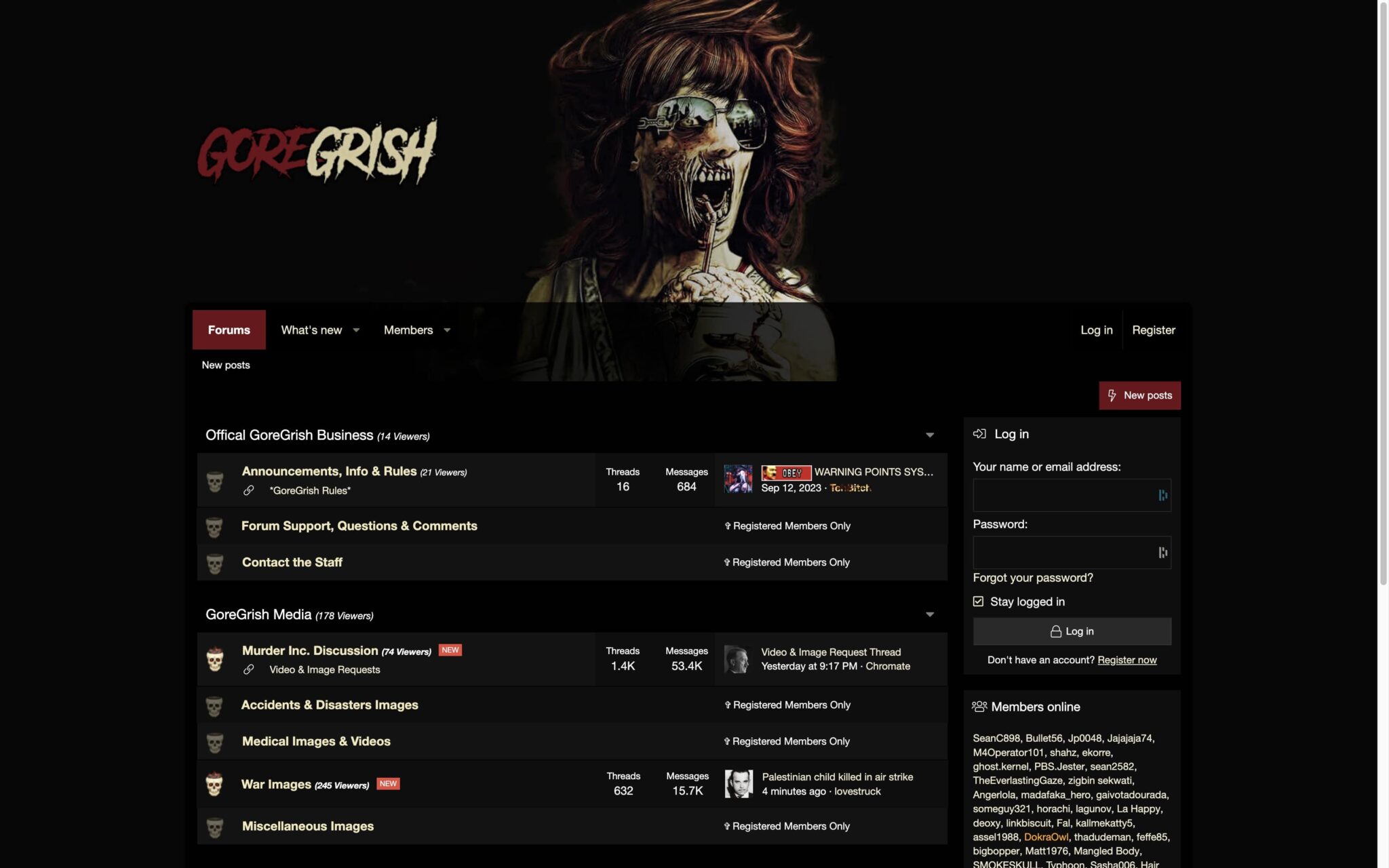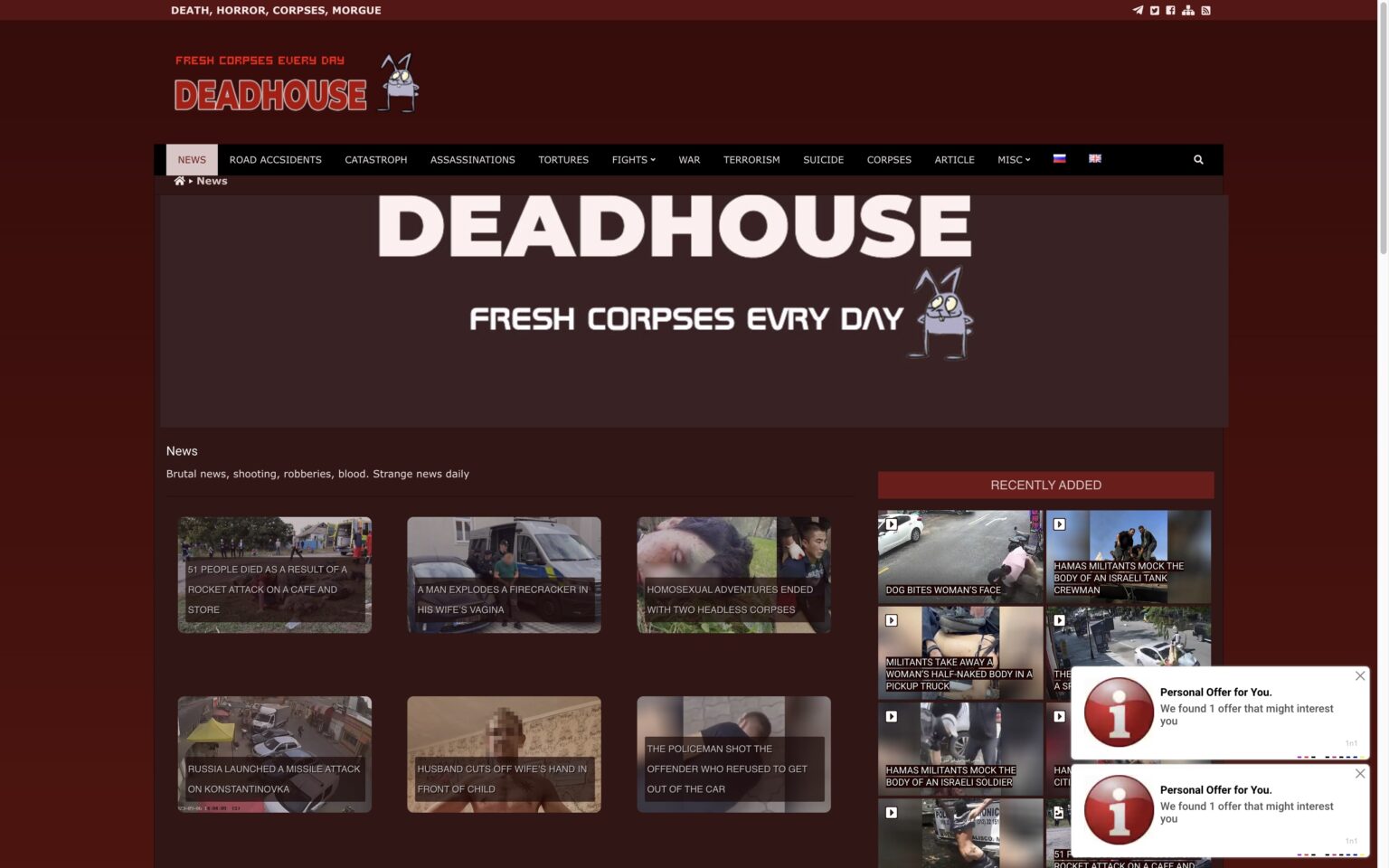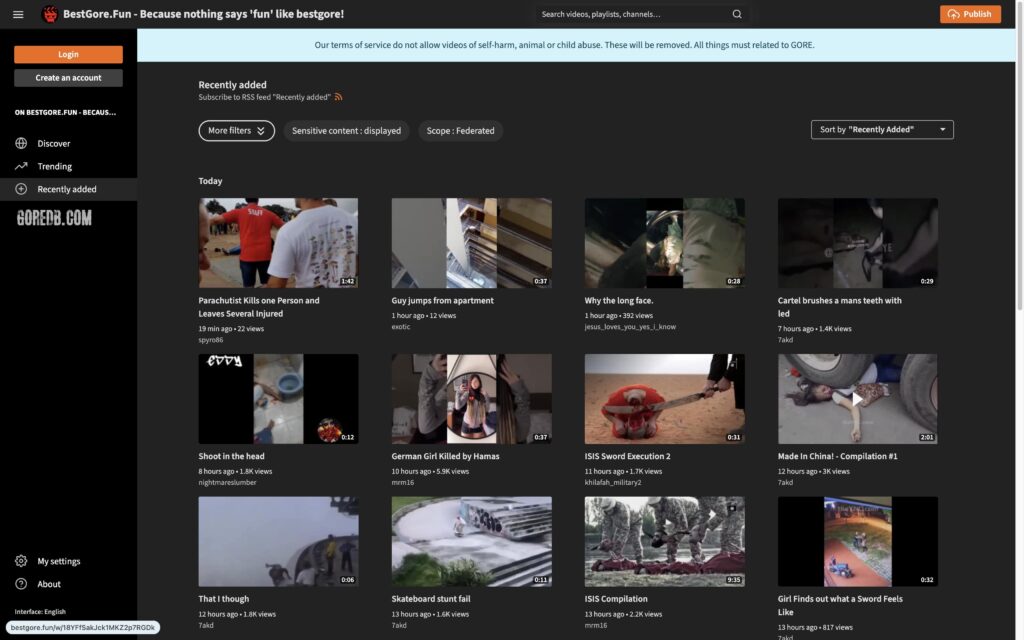Do websites pushing the boundaries of acceptable content reflect a troubling desensitization, or are they simply providing a dark mirror to society's hidden facets? The internet's underbelly, exemplified by platforms like the now-defunct Bestgore, reveals an uncomfortable truth: a significant audience exists for graphic and disturbing content, raising serious questions about its impact and the ethics of its distribution.
The closure of Bestgore, a site notorious for hosting videos and images of extreme violence, death, and human suffering, was met with a mixture of relief and concern. Relief, because many believed its content was morally reprehensible and harmful. Concern, because its disappearance didn't necessarily eliminate the demand for such material; it simply scattered it across other, less centralized platforms. The internet, after all, is a hydra; cut off one head, and several more are likely to sprout. This raises fundamental questions about censorship, freedom of speech, and the responsibility of internet service providers and social media companies to moderate harmful content. The debate becomes even more complex when considering the varying cultural norms and legal frameworks that exist across different nations. What might be deemed unacceptable in one country could be tolerated, even considered permissible under freedom of expression, in another.
The existence of sites like Bestgore highlights a darker aspect of human psychology: the morbid curiosity that draws individuals to witness the macabre. Evolutionary psychologists might argue that this fascination stems from a deeply ingrained survival mechanism – a need to understand danger and learn from the misfortunes of others. However, the accessibility of graphic content through the internet can potentially distort this natural impulse, leading to desensitization and a diminished capacity for empathy. The constant exposure to extreme violence, even in a virtual context, can erode the viewer's perception of reality and potentially influence their behavior.
- Movierulz Alternatives Watch Telugu Movies Online Legally
- Movierulz The Dark Side Of Free Movie Streaming Know The Risks
One of the central arguments against sites featuring graphic violence is its potential impact on vulnerable individuals. Children and adolescents, whose brains are still developing, are particularly susceptible to the harmful effects of such content. Exposure to extreme violence can lead to anxiety, depression, and a distorted understanding of the world. Furthermore, it can normalize violence and desensitize individuals to the suffering of others. This is where parental controls, media literacy education, and responsible internet usage come into play. Educating young people about the potential dangers of online content and equipping them with the critical thinking skills to evaluate what they see is essential in mitigating the harmful effects.
The legal landscape surrounding sites like Bestgore is complex and varies significantly across jurisdictions. In some countries, the distribution of graphic content may be illegal under laws related to obscenity, hate speech, or incitement to violence. However, enforcing these laws can be challenging, particularly when the websites are hosted in countries with more lenient regulations. The anonymity afforded by the internet also makes it difficult to identify and prosecute individuals who upload and share illegal content. International cooperation and the development of consistent legal standards are crucial in addressing the global challenge of online extremism and harmful content.
Beyond the legal and ethical considerations, the existence of sites like Bestgore raises questions about the role of technology companies in shaping online content. Should social media platforms and internet service providers be held responsible for the content hosted on their servers? This is a contentious issue, with strong arguments on both sides. On the one hand, holding companies liable for user-generated content could stifle free speech and innovation. On the other hand, allowing platforms to operate without any accountability could enable the proliferation of harmful content and contribute to the erosion of societal values. Finding a balance between these competing interests is a critical challenge for policymakers and tech leaders alike.
- Movie Streaming Guide Jiohotstar Movierulz More
- Unveiling Kannada Cinema Exploring The 5 Movie Rules More
One potential approach is to focus on empowering users with tools to filter and block unwanted content. Parental control software, content filters, and reporting mechanisms can help individuals and families protect themselves from exposure to graphic violence and other harmful materials. However, these tools are not always effective, and they can be circumvented by tech-savvy users. Furthermore, they place the burden of responsibility on the individual user, rather than on the platforms that host the content.
Another approach is to encourage media literacy education, which equips individuals with the critical thinking skills to evaluate and interpret online content. By teaching people how to identify misinformation, propaganda, and harmful content, we can empower them to make informed decisions about what they consume. Media literacy education should be integrated into school curricula and made available to adults through community programs and online resources.
The debate surrounding sites like Bestgore is ultimately a reflection of broader societal tensions between freedom of expression and the need to protect vulnerable individuals from harm. There are no easy answers, and finding a solution will require a multifaceted approach that involves legal reforms, technological innovation, media literacy education, and a willingness to engage in difficult conversations about the ethics of online content. The absence of Bestgore hasn't eradicated the underlying demand; it has merely shifted it elsewhere. The challenge now is to address the root causes of this demand and create a safer and more responsible online environment.
The very existence of "sites like Bestgore" compels us to confront uncomfortable realities about human nature and the potential for technology to amplify both the best and worst aspects of our society. While many hope that such sites remain confined to the darkest corners of the internet, understanding their appeal and impact is crucial for navigating the complex ethical landscape of the digital age.
Several factors contribute to the allure of graphic content, often found on "sites like Bestgore". Psychological research suggests a combination of morbid curiosity, a desire to confront taboo subjects, and even a form of thrill-seeking can drive individuals to seek out such material. The anonymity of the internet further emboldens some to explore content they might otherwise avoid in real-life social settings. Furthermore, the algorithms of social media and search engines can inadvertently create echo chambers, exposing users to increasingly extreme content based on their initial search history or viewing habits.
The economic incentives behind sites featuring graphic content also play a significant role in their proliferation. Advertising revenue, subscription fees, and even the sale of user data can generate substantial profits for website operators, even if the content is morally questionable or legally dubious. This financial motivation can create a perverse incentive to push the boundaries of acceptable content in order to attract more viewers and generate more revenue. The lack of effective regulation and oversight in many jurisdictions further exacerbates the problem.
The long-term psychological effects of repeated exposure to graphic violence are still being studied, but preliminary research suggests that it can lead to desensitization, increased aggression, and a diminished capacity for empathy. Individuals who regularly consume violent content may become less responsive to the suffering of others and more likely to accept violence as a normal part of life. This is particularly concerning for young people, whose brains are still developing and who may be more susceptible to the harmful effects of such content.
Addressing the problem of "sites like Bestgore" requires a comprehensive approach that involves collaboration between governments, technology companies, civil society organizations, and individual users. Governments can enact and enforce laws that prohibit the distribution of illegal content and hold website operators accountable for the material hosted on their servers. Technology companies can develop and implement algorithms that detect and remove harmful content, and they can provide users with tools to filter and block unwanted material. Civil society organizations can raise awareness about the dangers of online violence and promote media literacy education. And individual users can make informed decisions about the content they consume and report any illegal or harmful material they encounter.
One promising approach is the development of artificial intelligence (AI) systems that can automatically detect and remove graphic violence from online platforms. These AI systems can be trained to identify patterns and characteristics of violent content, such as blood, gore, and depictions of suffering. While AI is not a perfect solution, it can significantly reduce the amount of harmful content that is available online. However, it is important to ensure that AI systems are used responsibly and ethically, and that they do not inadvertently censor legitimate content or discriminate against certain groups.
Another important step is to promote media literacy education, which teaches individuals how to critically evaluate online content and identify misinformation, propaganda, and harmful material. Media literacy education should be integrated into school curricula and made available to adults through community programs and online resources. By equipping individuals with the critical thinking skills to navigate the online world, we can empower them to make informed decisions about the content they consume and protect themselves from the harmful effects of online violence. This is particularly crucial in the age of deepfakes and other forms of manipulated media, which can be difficult to distinguish from reality.
Ultimately, addressing the problem of "sites like Bestgore" requires a fundamental shift in our attitudes towards online content and a greater sense of responsibility on the part of both individuals and organizations. We must recognize that the internet is not a lawless frontier, and that the same ethical and legal standards that apply in the real world should also apply online. By working together, we can create a safer and more responsible online environment for all.
The allure of "sites like Bestgore" also stems from a complex interplay of psychological and sociological factors. Some researchers suggest that the consumption of violent content can be a form of escapism, allowing individuals to temporarily detach from the stresses and anxieties of daily life. Others argue that it can be a way of asserting control in a world that often feels chaotic and unpredictable. Still others believe that it can be a form of rebellion, a way of challenging societal norms and pushing the boundaries of acceptable behavior. Whatever the underlying motivations, it is clear that the demand for graphic content is deeply rooted in human psychology and that addressing it will require a nuanced and multifaceted approach.
The role of social media platforms in amplifying the spread of graphic content cannot be ignored. The algorithms that govern these platforms are designed to maximize engagement, and they often prioritize sensational and controversial content over more informative or constructive material. This can create a feedback loop, where users are increasingly exposed to extreme content based on their initial search history or viewing habits. Social media platforms have a responsibility to address this problem by modifying their algorithms and implementing stricter content moderation policies.
The legal and ethical challenges posed by "sites like Bestgore" are further complicated by the fact that the internet is a global network, transcending national borders and legal jurisdictions. This makes it difficult to enforce laws and regulations, as website operators can simply relocate their servers to countries with more lenient regulations. International cooperation is essential to address this problem, but it is often hampered by conflicting legal frameworks and cultural norms. The development of international legal standards and the establishment of cross-border law enforcement mechanisms are crucial to effectively combat online extremism and harmful content.
The debate surrounding "sites like Bestgore" also raises fundamental questions about the nature of free speech and the limits of censorship. While most people agree that certain types of content, such as hate speech and incitement to violence, should be prohibited, there is less consensus on what constitutes harmful or offensive content. Some argue that any attempt to censor online content is a violation of free speech, while others believe that the protection of vulnerable individuals from harm should take precedence. Finding a balance between these competing interests is a complex and ongoing challenge.
The closure of "sites like Bestgore" may have reduced the availability of graphic content online, but it has not eliminated the underlying demand. This demand has simply shifted to other platforms, such as dark web forums and encrypted messaging apps, where it is more difficult to detect and regulate. Addressing the problem of online violence requires a continuous and adaptive approach, one that is constantly evolving to keep pace with the ever-changing landscape of the internet.
Ultimately, the solution to the problem of "sites like Bestgore" lies in fostering a more responsible and ethical online culture. This requires a collective effort on the part of governments, technology companies, civil society organizations, and individual users. By working together, we can create an online environment that is safer, more informative, and more respectful of human dignity. This is not just a technological challenge; it is a moral and societal one.
The legacy of "sites like Bestgore" serves as a stark reminder of the potential for the internet to be used for both good and evil. It underscores the importance of critical thinking, media literacy, and responsible online behavior. As we continue to navigate the complex and ever-evolving digital landscape, it is crucial to remember that technology is merely a tool, and that it is up to us to shape its use in a way that promotes human flourishing and protects the vulnerable.



Detail Author:
- Name : Meta Kuhn
- Username : taya.crist
- Email : ari.champlin@gmail.com
- Birthdate : 2004-04-10
- Address : 9140 Grayson Route Zanderside, LA 36066
- Phone : (610) 855-0265
- Company : Casper-Fisher
- Job : New Accounts Clerk
- Bio : Eius quia a temporibus porro et odio. Consequuntur quis quo qui omnis iusto quisquam. Minima omnis neque qui nemo quam.
Socials
twitter:
- url : https://twitter.com/ricobahringer
- username : ricobahringer
- bio : Voluptatem culpa doloribus qui. Reprehenderit et nihil libero qui eum libero. Doloribus in aut aut nulla omnis in. Nesciunt harum quo vel et repellendus esse.
- followers : 4760
- following : 1174
linkedin:
- url : https://linkedin.com/in/rico_dev
- username : rico_dev
- bio : Earum totam aut architecto sed nam voluptatem et.
- followers : 4135
- following : 881
facebook:
- url : https://facebook.com/bahringer1982
- username : bahringer1982
- bio : Praesentium sint nobis sit tempora quibusdam. In esse maxime qui vitae.
- followers : 555
- following : 12
instagram:
- url : https://instagram.com/bahringer2019
- username : bahringer2019
- bio : Harum ipsa quasi odio qui. Quod cum tempore ex ducimus.
- followers : 6875
- following : 2961
tiktok:
- url : https://tiktok.com/@rico_official
- username : rico_official
- bio : Sapiente iusto beatae vitae nemo enim ut quis.
- followers : 4275
- following : 1086